Boat Profile
A Stevenson project
From Issue Small Boats Annual 2021 March 2020
T he Weekender is a plywood gaff-sloop pocket yacht designed by Peter Stevenson and first presented to the public in a two-page article in the March 1981 issue of Popular Science magazine. In the decades that have followed, it has been a very popular design. I was drawn to its classic look and simple construction. Eager to learn how to sail—and to find out if my wife would enjoy sailing too—I was excited about the journey of the build and encouraged by the many helpful examples of other builders who are linked to the Stevenson website.
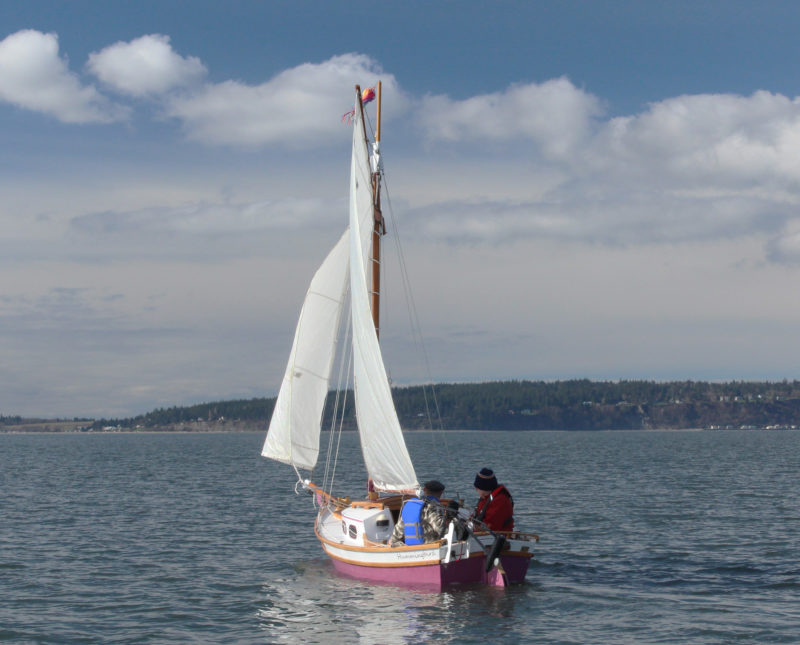
The Weekender draws 3′ with the rudder deployed; with its blade retracted, the hull draws 1′.
I bought the set of plans and the two companion DVDs. The combination of the 44 printed pages and three-and-a-half hours of video were helpful, entertaining, and, above all, encouraging. The plans are well illustrated with some photos and many nice drawings. There are no full-sized patterns, so each part is drawn right onto the materials. Step-by-step instructions keep the process going in the correct order. As a shipbuilder, I found the instructions clear and straightforward. My granddaughter, who was three years old when we started and nearly seven when we finished, was as eager to build the boat as I was, and we watched the video instructions several times together. Even at her young age, she could recognize the steps we had completed and the ones we had yet to accomplish, a good indication of how easy the plans were to follow. For me, the video clarified the few places in the plans that I was having difficulty understanding. Mike Stevenson, Peter’s son, who took over the business, has assured me that the most recent revision has eliminated some of those sticking points.
The Weekender has a very unusual construction: it is built right-side up with the stem and keel serving as the strongback. The deep keel and its integral stem are made of three laminates of 4/4 pine, fir, or mahogany. The keel, 10″ at its deepest, is rigid enough to support the build. I built a cradle to hold it upright throughout the build. Plywood is joined with butt plates to get the necessary length and width for the bottom panel; the bottom is attached to keel with screws and epoxy. The deck is added and secured at the stem and then temporarily propped up until the transom and three bulkheads are installed. The side panels go on next and they’ll extend above the deck to become part of a toerail. The construction then follows a more common sequence, with the assembly of the cockpit and the cabin. The hull, deck, cockpit, and cabin are sheathed with 6-oz fiberglass and epoxy.
The plans indicate a solid mast, and I built mine as per the instructions; however, a lighter hollow version would be much easier to raise. Details to build the wheel, trailboards, towing bitt, and bowsprit are included. There is also an option included to add a taffrail.
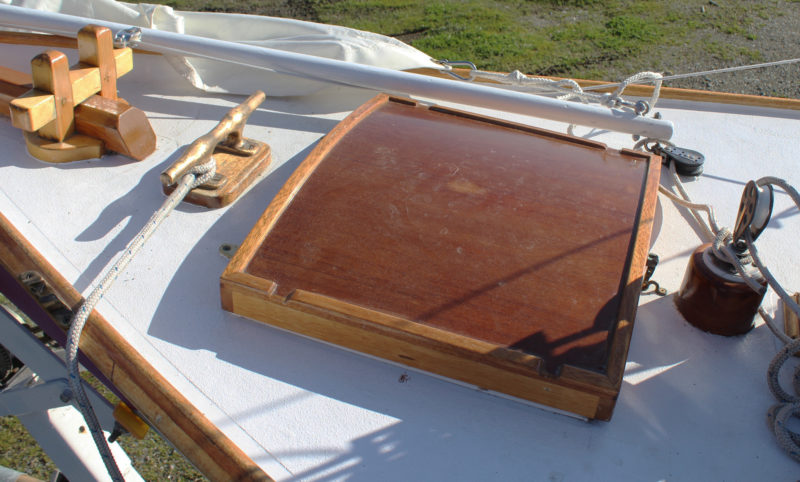
The forward hatch provides access to the storage space in the bow. The block to the right, held upright by a spring, is for the single sheet that controls the jib boom.
M y PT Cruiser has enough power to pull our Weekender. The boat has a somewhat deep keel for a flat-bottomed boat, so bunks are required under chines to support the hull. At the ramp, it’s easiest to float the boat off the trailer; at shallow ramps it can be a bit of a struggle sliding it off, in part because the two batteries I use for the trolling-motor auxiliary power add significantly to the Weekender’s weight. However, the boat can be winched up onto a trailer that’s not fully submerged. It takes as little as 30 minutes after arrival at the ramp to get the rigging in place and have it in the water; the most time-consuming part of launching and loading the boat is almost always the attention it attracts from people watching. When people gather around, the time at the ramp stretches out to a bit more than an hour.
The mast tabernacle is created with two strap hinges—one aft to act as the pivot, and one forward with a loose pin to lock the mast upright—and it works well. The two pairs of shrouds have turnbuckles that are adjusted each time the mast is raised; they remain connected, and only the forestay is removed for lowering the mast.
The 5’ bowsprit is fixed and anchors the forestay at its tip and the jib’s 60″ clubfoot at its middle. The club foot pivots about halfway out on the sprit, and the jib clears the mast when tacking and requires only a single sheet. I have added a downhaul to the jib so that I can both raise and lower the jib going no farther forward than the companionway. I also led the main’s throat and peak halyards to cockpit so I didn’t have to go forward to the mast to drop the sails.
To help keep the mainsail from overwhelming the cockpit when it’s lowered, I added lazyjacks. The plans specify eyebolts and a bit of pipe and metal strapping to make the gooseneck; I instead made an aluminum gooseneck with an extension that allows me to pivot the boom fully vertical and scandalize the mainsail. When coming into harbor, it’s a quick way to douse the mainsail and clear the cockpit for docking. This has proven most helpful especially when sailing alone. I also fabricated an aluminum masthead fitting to help with the rigging and give me a base for an anchor light and a wind-sock vane.
The rudder is in a rudder box that is an integral part of the tiller arm that is connected by lines and pulleys to facilitate a wheel. The rudder must be pivoted and locked up for transport. The wheel keeps the cockpit free of a long tiller that would most certainly use up the limited space. I find it quite handy.
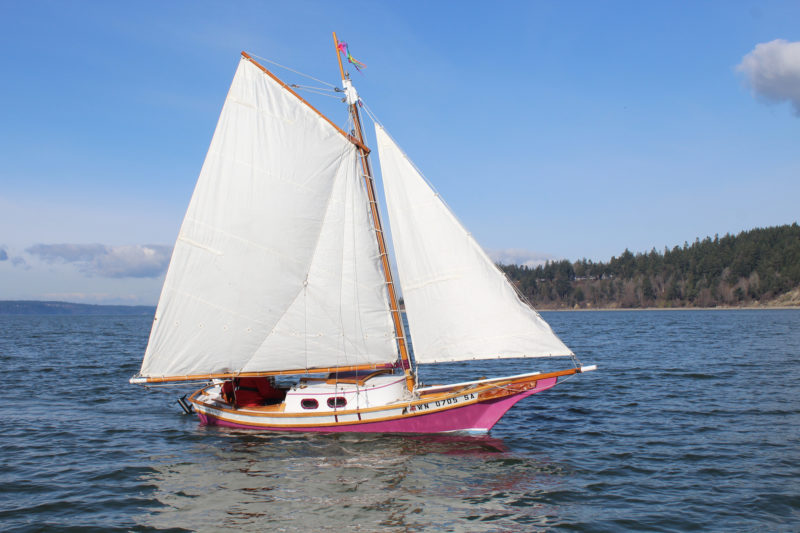
The Weekender carries a total of 120 sq ft of sail. The jib, with its boom and single sheet, is self tending, so tacking is uncomplicated.
U nder sail, the Weekender is like a sports car and very snappy in response on most points of sail. It can sail remarkably close to the wind for a gaff rig, and the self-tending jib makes tacking a snap. Its club foot is an excellent touch to the rigging, making singlehanding very simple. The Weekender can ghost along with hardly any discernible wind, although in light air it can be a bit hard to tack if the boat doesn’t have quite enough way on; the long keel requires some momentum to overcome its resistance to sweeping sideways when tacking. I have found that moving my weight to the downwind side forces the boat to heel, and it will gain speed and increase its ability to turn.
The Weekender is a pretty stable little boat, and ours is made a bit more so by the weight of the batteries for the trolling motor. It is stable when one is standing on the foredeck; however, it is a small boat, so if you step off-center it will move accordingly. But I have never felt that it was going to come out from under me.
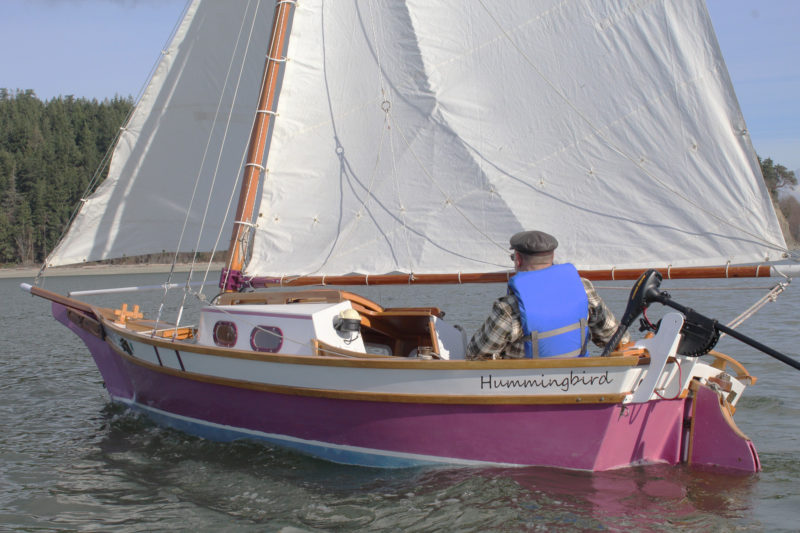
The Weekender was initially designed with a centerboard, but the full keel provided good performance to windward and the board and trunk were eliminated from the design, freeing up cabin space.
The hull can take waves better than one might guess for being so close to the water. The flat bottom can slap a bit depending on the angle of approach to the waves, but that same flat bottom can also surf down waves quite well, getting some help from the broach-countering directional stability of the full-length keel. I have found the cockpit to be generally dry with only occasional spray from hitting a larger wave. I prefer fair-weather sailing with our boat. When running dead downwind, wing-on-wing, the boat performs well; it’s a comfortable point of sail for the crew, with the hull sitting pretty much bolt upright.
For auxiliary power, we have a 55-lb-thrust electric trolling motor. While the plans call for a mount made of a 2″ x 10″ chunk of wood through-bolted to the transom, I designed and welded an aluminum bracket. The motor pushes the boat at just the right speed for harbor maneuvers, and provides an occasional boost to make a tack in light air. I have the two batteries on separate switches, but they can be combined for back-up power. I have run out of power only when I forgot to charge one of the batteries.
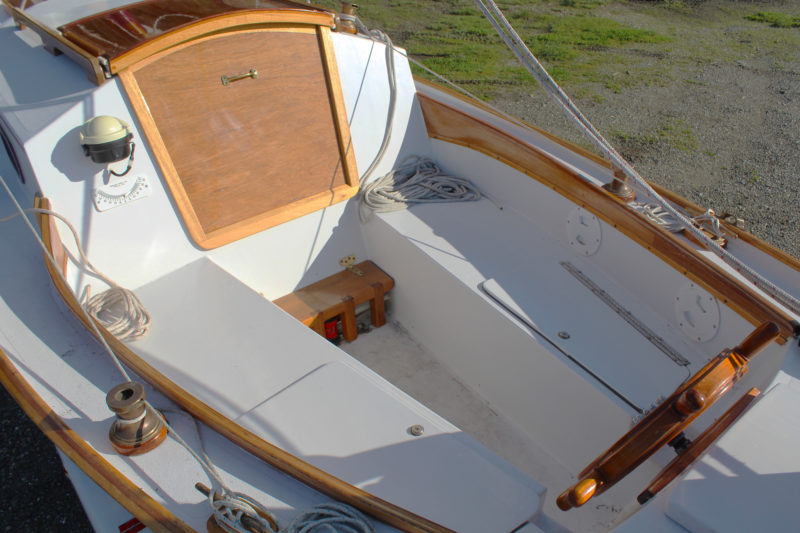
The cockpit benches include dry storage compartment aft and extensions of the cabin space forward.
The cockpit is not large, but it has enough room for the me and my wife to be comfortable, even when we’re sailing with our granddaughter and our small dog. The cockpit footwell is not self-draining and we have been caught several times in squalls that filled half of the cockpit, so I added a bilge pump under the hinged step at the forward end of the cockpit. The cockpit seats have hatches, and aft sections serve as storage. The curved coaming, shaped from a stack of 4/4 stock, makes a comfortable backrest and keeps water out when the toerail is in the water under sail. I cold-molded my coaming out of 1/8″ x 2″ sapele.
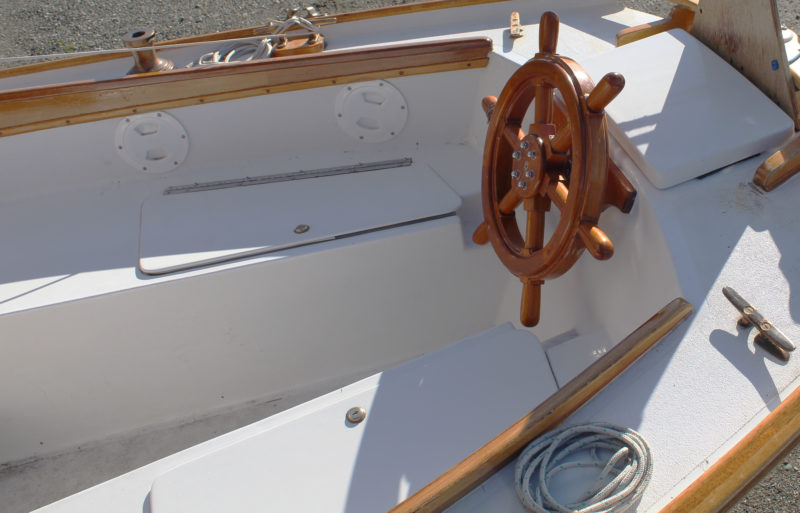
The wheel is more than an affectation. It doesn’t crowd the cockpit as a tiller would.
I added running lights to our Weekender as well as a small LED to illuminate the cockpit for the times when we are out later than expected or after dark at anchor. My wife and I have slept aboard comfortably on several occasions. We rig a boom tent for privacy and rain protection so we can keep the companionway open through a warm night; to clear the berths, we move most of the gear that usually resides in the cabin into the cockpit. The bottom serves as the berth and is flat, save for one transverse butt block, but with foam mattresses it’s not noticeable. The space works best sleeping with heads forward and our feet aft to take advantage of the space under the cockpit benches. Shelves with rails on their sides are a nice feature and are in fact part of the rigid framing.
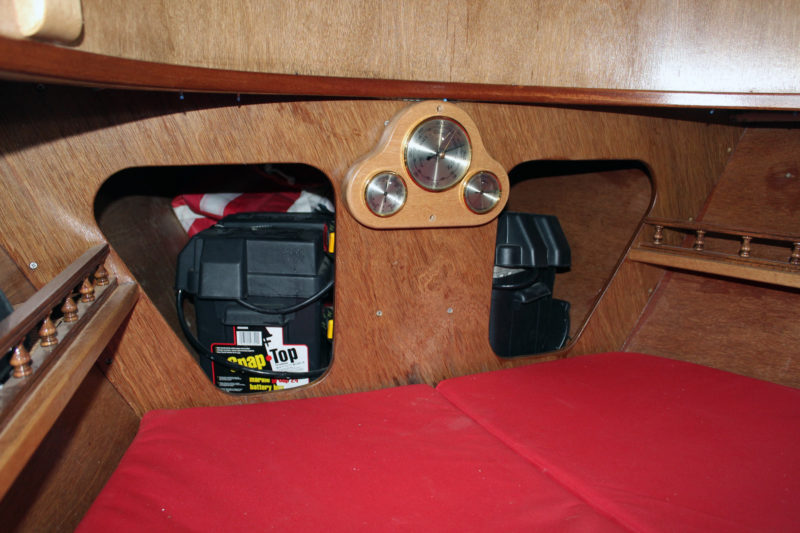
The bulkhead at the forward end of the cabin allows access to the storage compartment in the bow. Rails on the shelves port and starboard keep gear in place while under sail.
T he designed cabin has sitting headroom if you are of average height—I made our cabin a couple of inches higher than the design, for even more sitting headroom. There is no cabin footwell, so sitting is with legs outstretched on the bottom. There is access through the forward bulkhead to storage space under the foredeck, but it is easiest to use the foredeck hatch for larger items. The storage bin/seat at the companionway has proven to be a great addition for holding safety equipment, and it has also been a good speaker box for our CD player.
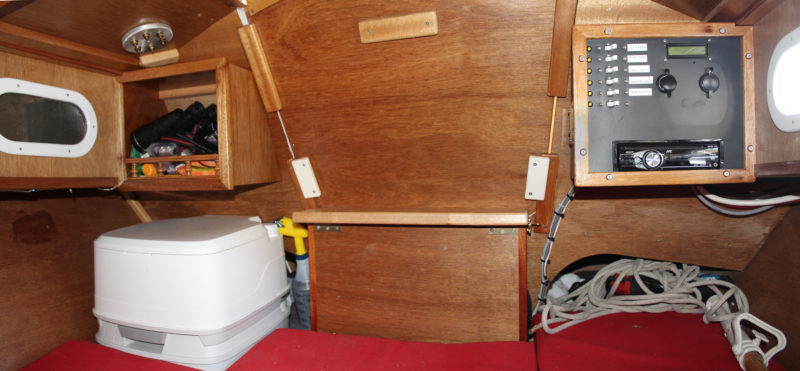
The aft end of the cabin provides a place to stow a portable toilet when it’s not in use. At right, one of the spaces under the cockpit benches is visible.
Ken Hauenstein lives in Burlington, Washington, just a few miles from Puget Sound, and is a general contractor who does all manner of work including interior boat remodels. He dreamed of working with boats from an early age and had his first real exposure working in a boat factory building interiors for cabin cruisers. He later worked in various shipyards and ran his own cabinet shop. His last shipyard job ended in 2017 as he made plans to retire. He started HUMMINGBIRD while working there. Since then he has built two dinghies, one wood and one aluminum. He is currently building a large aluminum ketch. He hasn’t set a launch date, and won’t because he finds the work therapeutic and likes to give the details all the attention they deserve.

Weekender Particulars
LOA/19′ 6″ LOD/16′ Beam/6′ Draft/3′ (1′’ with the rudder up) Hull weight/550 lbs Sail area/120 sq ft Crew capacity/Daysailing, up to four; Overnight, two cozily, one easily Auxiliary Power/up to 5 hp outboard or 45-lb thrust electric
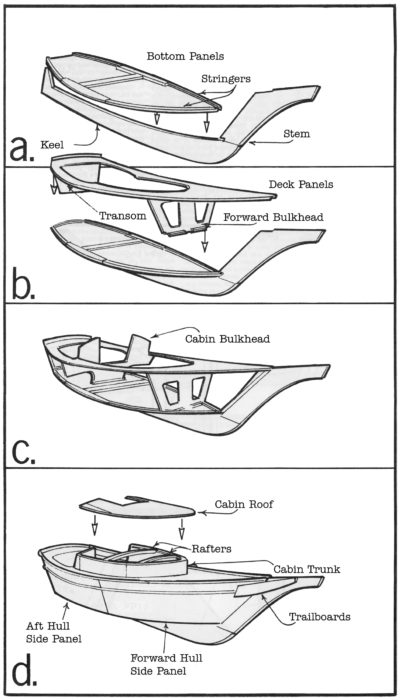
Plans ($45) and DVDs ($57) for the Weekender are available from Stevenson Projects .
Is there a boat you’d like to know more about? Have you built one that you think other Small Boats Magazine readers would enjoy? Please email us!
Share this article
Join The Conversation
We welcome your comments about this article. If you’d like to include a photo or a video with your comment, please email the file or link.
Comments (45)
Is there really enough headroom to use the porta-potti in the cabin?
The headroom in the cabin is limited to sitting, so the porta-potti is just stored there. I took the photographs for the review and I had only enough headroom for sitting on the floor cushions.
The cushions in the cabin have a removable section to move the porta-potti into the companionway should the need be dire. We have never used it since we put it in there however.
First, I would congratulate you for the amazing job you have done. I appreciate it as I’m currently building a Weekender for some time. The hull is quite finished now and the next step is the rig. I would be very interested in getting some pictures of the gooseneck and masthead that are looking very practical and better looking than the instructions suggested. J-Guy
I love my Weekender! It is indeed fun, stable and dry. Hoping this season to get a better video than this one from my iPhone.
J-Guy, Here are photos of the gooseneck and masthead fittings.
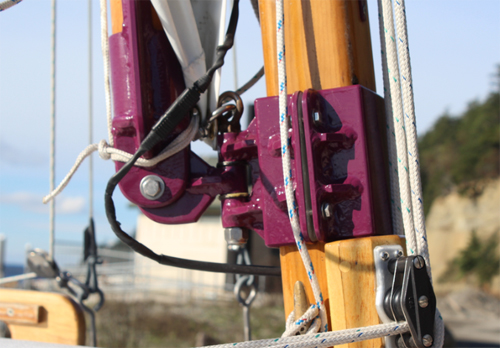
Who fabricated that for you?
Mark, I fabricated those myself. I was project manager in a shipyard while building HUMMINGBIRD and most of the parts I needed for them came out of the scrap bin. I fit and weld aluminum and steel.
When trailing: a) Does one unship the bowsprit so as not to need a trailer with a long front tongue? b) Do the spars stow within the length of the deck or overhang? Thanks in advance
I enjoyed the Weekender article, especially because I have built one of these boats. I hope this photo of my boat on the trailer will help answer Simon’s question. Notice I bolted on a short 2 x 10 forward on the trailer to carry the outboard motor, which is easily carried to the transom prior to launch. This way, potholes on the highway don’t bother me so much. The boat sets up quickly for sailing.The trailer is a bit large for the boat. The wider and lower bass-boat-size trailer gives a better towing experience and it all still fits in my garage.
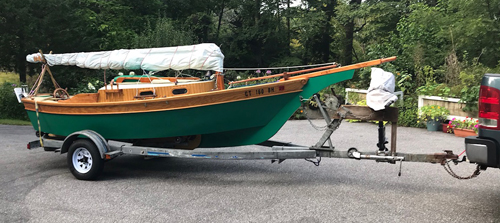
I have built and sailed a Weekender. I sailed it for four years. I have 30 years of sailing experience, and can tell you this design has some very serious flaws, mostly around safety, that I realized as I sailed it. First, it’s not self righting. At all. If you put it over, you are done. It will not pop back up, and becomes almost impossible to right again without help. And even if you get it back up, it cannot be bailed easily. And this assumes having as much flotation installed as you can! Without flotation, it might very well go under. It has no low ballast, which is a problem in many ways. Also, it has a very difficult time coming about. Very, very difficult time. It has to do with the sail plan, the hull shape, and the full length keel. I modified the keel quite a bit after the first year, adding to the center, and reducing it from the front 1/2, and that helped, but it still had a hard time coming about. This boat should only be sailed in very protected waters in 12 knots or less wind. it is easy to build, easy to trailer, and easy to beach, and looks very salty, but it has very poor sailing characteristics. Go to WoodenBoat’s forums and search for the Weekender. I wished I had before I built it!
I’ve made five Weekenders, two Vacationers, and two Skipjacks, and all have very similar hull forms. We have sailed them in a broad range of conditions and locations. They tack fine, they point better than they probably should, and they just work. I’ve never capsized any of them, although I have felt them being overpowered at times and adjusted accordingly by easing off, reefing, or heading back in. There are all sorts of responses to strong wind, depending on the boat and the days.
I’m sorry that John built one of our Weekenders without really understanding what the boat is and what it is not. Like many pocket cruisers, the Weekender is not a ballasted, self-righting boat. Self-righting isn’t a standard that many sailing dinghy, pod-type boats, open sailing skiffs, dories, or other traditional boats meet.
I just fielded a query from a customer a few days ago about whether to add ballast or not to a Skipjack, our 14’ open-cockpit gaff sloop. He had wanted to add 300 lbs of ballast to the keel of a 240-lb boat. The boat’s structure is not designed for this load, and the addition of ballast that close to the hull bottom and not extended away from it on a keel just wouldn’t be that helpful and wouldn’t make the boat self-righting. If someone doesn’t know how to sail an open dinghy, it’s probably not for them.
I’m sorry John had trouble sailing his Weekender, but we think the design sails well, given the limitations of a low-aspect-ratio gaff rig and a modified dory-type hull form. Over the decades, we have had a far more positive letters, emails, and phone calls about these boats than negative. Even the review here reflects this. We are sensitive to the fact that there are people who don’t have a feel for sailing these types of boats, or perhaps haven’t the range or depth of experience to draw from, and might well be frustrated that tacking a Weekender is not like tacking like a Capri 14 or some similar easy-to-sail machine with a centerboard. We have a section in the plans to help with sailing and tacking, and a good amount of discussion in the video as well.
I am truly sorry to hear, and entirely sympathetic with the unhappiness of having spent a lot of time building a boat only to be disappointed by it, but I don’t think that necessarily indicates a failing of the boat design. The Weekender, like the Vacationer and Skipjack, does tack fine, and it is an unballasted boat that is not self-righting. That’s the nature of the beast, and I’m sorry if it didn’t meet the expectations of a different boat.
I don’t think it’s possible to come up with a perfect design which will please and be all things to everyone. We surely don’t want to even hint that our little Weekender is anything like that. It is what it is: a cute, easy-to-build little sailboat with a classic-boat feel.
Mike Stevenson Stevenson Projects
I’ve had one I built for 19 years. I have had a lot of fun with my little boat, and it’s still happily sailing every summer. I sail her pretty enthusiastically, and have not had any problems. My dinghy-sailing training from when I was a kid prepared me for sailing a small, unballasted boat, so I didn’t suffer from any of the misapprehensions some folk seem to when they expect this boat to behave like a large, ballasted, round-bottomed keelboat- even when they ought to know better considering they built it themselves. It’s a fun little dinghy and is just right for camping with the built-in shelter. It can be rowed with oars or propelled by a trolling motor. It’s great for poking around islands and beaches and campsites.
Hi, Could Keith Shergold help me with the placement of the oar lock location and what would be the best oar length for my Weekender sailboat? Where do you think the best spot for the midship cleat would be? I am also building the trailer for my Weekender, so if you know where the axle placement location is best (noted distance from the back of the cabin bulkhead at seat level). Note there is no other builder nearby to help get the spec. from, so I would appreciate any input. I am stuck at the plywood build finish stage, and need to know where to put the backing in so I can get doing the real scary stuff: fiberglassing. I do not have heat in my garage so I have to wait for a dry sunny day with no or light wind, for the right conditions. So one more question: How much epoxy did you need to ‘glass? This is important to know because I live at the Lake, West Cove, Alberta, Canada, and need to go over an hour to the nearest possible supplier. I do not know at this time who is still open.
I bought the plans 20 years ago and have been sailing fiberglass boats since. I bought the revised plans last month and have the means to follow through this time. MEYG will be sailing in 2021 or 2022 out of Fairport Harbor on Lake Erie. “Life is too short to sail an ugly boat.” ~Anonymous. I don’t plan to take her out in a gale, but I think she will be a great boat for a single handed-sailor.
As I have mentioned before, I’ll put in a plug for water ballast. I like the clear poly water “cubes”, with a handle, as they come in different sizes (1 gal. to 5 gal.) and can be shifted easily as needed. One main advantage is that, in case of a capsize, the ballast has neutral buoyancy, and won’t sink the boat. Of course, water ballast won’t provide the righting moment that lead or iron sash weights will, but this safety factor to me is a strong argument.
At the end of the day, just dump the water out. No need to wrestle heavy ballast around once you’re back on shore.
Let me clarify: I’m not saying you shouldn’t build it. But if you are looking for a boat that seats more than three (and three is tight), is a responsive sailor, and you know you might get caught out in winds over 15 mph from time to time, this is not the boat for you. I decided to build this boat because of the way it looked, and its ease of building, and the fact that you use off-the-shelf parts for most of it. I realized afterword that I wanted a better performing boat. I sold it and bought a Montgomery 15, which is a better fit for me. And I will restate, I have a lot of sailing experience, and have sailed many different sizes and types of boats. This was the first I built. It does have problems coming about from time to time. Not always, but in certain wind conditions. At first I thought it was me, then after sailing other boats and coming back, I realized this design has some tacking problems. Is it a deal breaker? No. I would fall off a bit and try again, and could usually get through the second time. Pros: Easy to build esp. for beginners Easy to launch and trailer with pulpit design Can be beached Looks very salty Cons: Not self-righting or self-bailing Not a performance sailor Keep in protected waters Sail in winds under 12 knots (15 mph) unless you are an experienced sailor and have experienced crew
Here’s the Woodenboat Forum link . Lots of discussion here, and other folks with more experience than me. Same conclusions. Many defenders and detractors. I’m just stating my experience, and wish no ill will. It is easy to build, it looks great, and if you are looking for a boat to get out on a Saturday afternoon in protected waters, this is a great choice. It’s sailing characteristics are okay to good.
Thanks, John!
I appreciate your honest assessments and comments. It’s nice to have balanced forums and genuine information for people to learn from.
Mike Stevenson Projects
John, We have had one occasion in which an odd wind shear hit us during a tack and we rolled far enough to scoop water with the cockpit coamings. My wife got pretty wet. I let go the main sheet and she righted immediately. I have found the two batteries in the fore-peak do add a bit to her righting ability.
Hi Ken, I saw your sailboat pictures. Your side deck and cabin top had round wooden spools. Being new to sailboat building for myself and having none in the area, I was wondering are they fixed turning posts, ratcheting posts, or winches? And what are their designed uses? Your boat looks really nice in the pictures. Just viewing them is enough to make me want to finish my Weekender. Thanks
Gerald, They are actually bronze winches I salvaged from a boat we cut up in the shipyard I used to work at. The side-deck winches I use rarely except to tie things off. The cabin top winch I use to raise the main. It adds a bit more purchase.
Sorry to hear John had such an unpleasant experience with his Weekender.
I built one over the course of 7 years, making only one change to the plans … two 10″ x 18″ lexan panels on either side of the keel just forward of the storage box in the cabin giving me a “glass bottom” sailboat ! Helps the fishing and scalloping a great deal as our area ( Old Homosassa, Fl. 65 miles North of Tampa on the Gulf Coast ) has very ” skinny water”. That is anywhere from 24″ to 48″ unless one is in the river channels or the Gulf. HEART SONG has proven to be a very good sailor even in 20+ knot wind and seas in the Gulf. As always, the performance of a boat is generally equal to the performance of the crew.
As for self righting and being hard to tack ….. first of all … DO NOT cleat off or sit on the mainsheet ! If you get the lee rail in the water let the main out ! As for tacking … you will need to build up some good headway, then put the helm hard over in one quick motion (don’t be timid here). If in light airs it helps to backwind the jib, easily done with a club-foot jib.
What really helps here is to have some multi-hull sailing experience as the Weekender sails more like a “Multi” than a “Mono.” As for not being self-righting and difficult to tack, well the same can be said for one of the most popular afternoon sailboats ever built with over a million sailing worldwide. A design that has introduced thousand to the wonderful world of sailing. It’s called a HOBIE CAT. Our WEEKENDERS are in good company indeed !
Oh man, pictures please!
My wife and I had one of these in 1986 and sailed it on many lakes in Alaska. It was surprising how well it sailed. We were on Lake Louise one time and it was really blowing, we were getting pushed to the other side of the lake and we were getting concerned. I could not get the boat to come about, I finally insisted my wife raise the job and voila we came about and back to the dock. On another trip to Harding Lake we ended up racing a pretty modern ‘glass boat, I had the rail down in the water and water 1/2 way up the on the portholes, we ended up passing the other boat and we were hooked.
Great work! I just finished mine, have had a chance to sail it twice and am lovin’ it. I miss the build though – really enjoyed the process.
I was so excited to find a recent AND positive review on S.P. boats. My Pocket Cruiser is almost done and I am very happy with it. I made a few modifications, but overall it is great. Once I understood the type of boat it is and its positive attributes, it was perfect for my purposes. I am glad to see so many happy reviews. I’ve been planning to put an 86-lb trolling motor on it; I was so excited that a 55 -pounder does the trick.
Hello, Dennis,
I look forward to seeing your P.C. when you get it launched! I have a soft spot for that boat, as I did most of the design work on that one. It has a very different feel from the dory-type hulls: The beamier cat-boat-inspired hull is really mellow and relaxing! Peter and I were once sailing the prototype in shallow water and didn’t realize we’d caught one of the lee-boards in the mud! We were happily talking away, just enjoying the gentle slap of the water and the light breeze, and then one of us said “Hey! I don’t think we’re moving anymore!” We laughed and pulled the board up and jibed around out of the shoal, but it really was a funny, mellow moment! I hope you have great fun with yours! Mike Stevenson Projects
Are those the battery boxes I see in the forepeak? I suppose it would make sense to try to balance out the weight of two adults in the cockpit.
I know in our Weekenders, we put the batteries up forward. The boat likes a bit of weight up forward to balance things, as you noted. I hate the longer wire runs, but larger gauge wires and 24v motors help minimize the losses. Mike Stevenson Projects
Yes, those are the battery boxes. My thinking, in addition to what has already been mentioned, was that the extra weight at the base of the mast would help work against the leverage in those moments when you may have held the main sheet a little too long and to tight. As I mentioned earlier, it has proven to pull her back in tight circumstances.
I recognize a lot of the names posting, and give you my support. I am building a Vacationer, a few hours a day, and am within a few weeks of painting the hull. The amount of time it takes to build depends on the level of finish on the boat. I am looking forward to being able to sail mine.
I’ve been sailing my Weekender for ten years now and have made many modifications to it. I wouldn’t change the basic boat at all now that I have a fairly good idea about how to sail it. I thought about ballast, but no way. I have done a capsize test with my Weekender and can tell you that mine pops right up with a little push on the keel. I’ve got a ton of floatation in mine and she floated pretty high when I took her over. I have also found that she will sail pretty well on her side if I don’t get nervous.
I crossed the Straits of Mackinac in twenty knots of breeze with no drama at all. I typically sail in winds in the high teens gusting well over 20 with the only downside being my old hands get tired. After ten years of learning to sail, she has never gone over on me and unless I have a stroke at the tiller I doubt that she ever will.
All around, best boat I can imagine.
Al, I can’t tell you how much my father would have loved to read your note. He was always very personally affected by letters and emails and photos our builders sent in, which makes sense: A big part of why he designed things was to create fun for people. The original books he wrote about wooden toys came about because he just wanted to make some toys for me. That started a legacy of projects which just keeps going, and I’m very proud and thankful to be a part of it and to keep it rolling along!
I love your adventurous sailing nature! Thank you so much for sharing your fun and spirit with us all!
This is very encouraging. Here in Brazil I met a guy with a Weekender, he said it was one of the best small boats he had ever owned
Mike, DUCKIE is my first boat build and even after building a number of wooden boats, she is still my ideal. What I mean about best all around boat is that she is by far the easiest boat to live with for this old man. I can manhandle her on her trailer, pull her with a Toyota Corolla, and handle all the wind I care to go out in. Set up and take down are the easiest that I have experienced, except for all the attention she gets at the ramp. Well, she did win her class at the Port Aransas show, so there’s that. She takes off like a scalded cat after a tack, which really turns my crank. She is way faster than most think she should be. On occasion, I have seriously perturbed skippers on bigger, supposedly faster boats by passing them and then waiting for them, good times. Describing her as a dirt bike on water is pretty apt. Her light-air ability is the best in my fleet. I could go on all day. Bottom line, learn how to sail a gaffer and take advantage of a sharp chine, and most will understand what I’m saying.
Al, I hear ya!! (and not just creator-bias: I have felt that kick in the pants when one tacks and Off We GO!)
All the best, and stay safe up thataway!
Very much enjoyed the article and all the discussions. She is a handsome little boat that I am sure is quite pleasurable to sail. I have a gaff-rigged Eastport pinky ketch and a Sedgwick Sailing peapod that I designed, based on the Washington County peapod shown in Chapelle’s book. She is 13’ 6”, reduced from 15’ 3” with a long straight keel. She tracks like she is on rails and accelerated rapidly. In response to the various comments regarding tacking, I have found that technique is key. Head up very slowly and just before you come up into the wind, kick the tiller over and voila! Never fails. There is no doubt you can have as much fun with a small boat as a big one. I’ve had a blast sailing with the Small Reach Regatta in Maine for the past few years. The Weekender would be a welcome participant. I always look forward to the monthly submissions. Thanks for sharing.
Yep, that sounds like great fun! I’d love to join you one of these years, if the Fates allow. I very much agree with you (not surprisingly!): The lightweight gaffer is a Fun Machine, and one only has to look at the shots of the sandbaggers of decades past to see the seriously-exciting-looking fun they seem to have been having!
All the best from the West Coast — Stay safe, all!
Great project! I fell in love with it as soon as I saw it. We should thank Peter for his talent for combining simplicity, reasonable seaworthiness, and beauty. I’ve already finished building my boat and I’m looking forward to going on a serious voyage.
I built my Weekender back in 2000 and completed her around 2005. Loved the building process and sailing her. I was truly amazed at just how well she handles and tracts. The gaff sail rig truly maximizes the sail area. Looking forward to building another one some day. And Mike, when I do I’ll order another set of plans from you. Great boat!
Beautiful workmanship! I especially love the character of the shipyard-leftovers and self-fabricated parts! How well suited would you say the sailing is to the area? Any modifications you’d make if you got to start all over again (besides the very sensible lights, headroom, etc. that you mentioned in the article)? I’m looking to build my first boat soon and I think I’m on the same water as you, Ken. Would definitely look forward to building a Weekender!
As a avid carpenter I am surprised at the absence of glassing after so much work into such a beautiful craft – I am envisioning a whole lot of screw joints coming ” disjointed ” as they eventually become wet and damp – What would be the offset to elevating the cabin roof another foot? Even at 2021-22 prices would anyone want a stiffer (rot-resistant) stem when putting this sprite under the stress of beaching, trailering, or keeling in a 25-knot wind? And ad yuears to her life? Well worth the mahogany or joined oak that she deserves. Comments welcome, especially those that have plied this beaut 10 years or better.
I have sailed my Weekender for over ten years now and can vouch for the toughness of the boat in all regards. I once sailed her up the rough concrete landing at a marina under full sail in twenty knots with no damage at all. I had a plastic shoe on the keel, but it was only scratched a bit. There was an avid crowd of witnesses at the time, and they were shocked to see me laughing and shoving her back in the water. If the landing is crowded, I always beach the boat out of the way to wait my turn, and over the years, my boat is like new. My keel is made of ACX 3/4 inch plywood which has stayed straight and un-degraded.
I glassed the entire outside, but left the interior for paint. I painted the interior very carefully to ensure that it would stand up to a dunking. As long as water doesn’t stand around inside she is okay.
I also added two inches to the height of the cabin, and I don’t think I would add more because I don’t want to ruin the look of the boat. I have noticed that the designers once built a Weekender with a pop up, or removable top. Not the worst idea if sitting upright is important. If I am going to spend any time in the cabin, I simply pile all my junk against the forward bulkhead and recline against that. I have also learned the drawbacks of too much windage, which the cabin is the primary culprit therein. You will notice it.
I`ve read this article about the Weekender Sailboat now twice. This is a very good description about the Weekender and I can really agree in all Points. I built one and yes it’s a joy to sail. I also raise the cabin height double than the original. It’s much comfortable. There is one Thing where I’m not so happy. The foredeck is drawn flat and the water can not flow overboard. Unfortunately I recognized it too late. In that time I was not so experienced in boatbuilding. Another thing was hard to learn the imperial measurements.
I present my Building Story on the Stevenson website. I hope you can enjoy
So thank you for this nice article to read.
With Kind regards from Germany!
Michael Beckmann
Leave a Reply Cancel reply
Your email address will not be published. Required fields are marked *
Stay On Course
More From This Issue
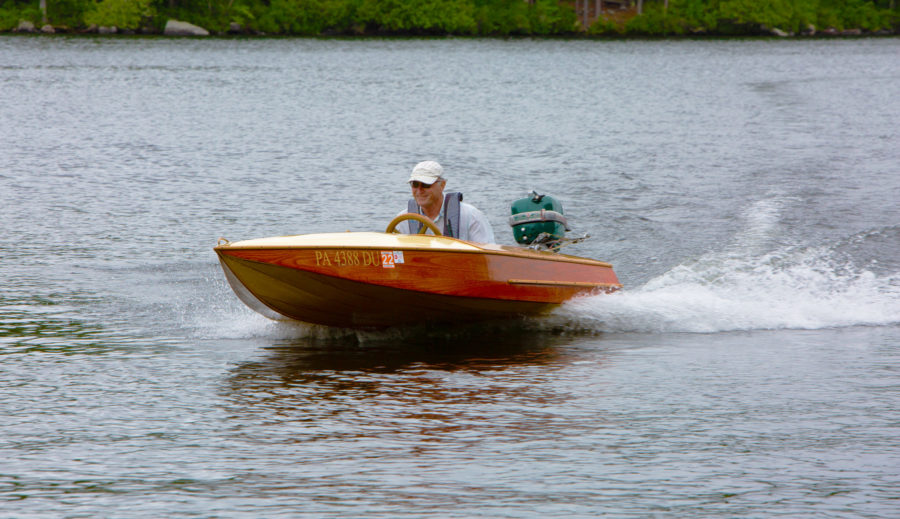
Midget Flyer
When I piloted the Midget, I found that at low speed its trim is close to level; the bow rides up slightly, but not in an unsightly manner. With a…
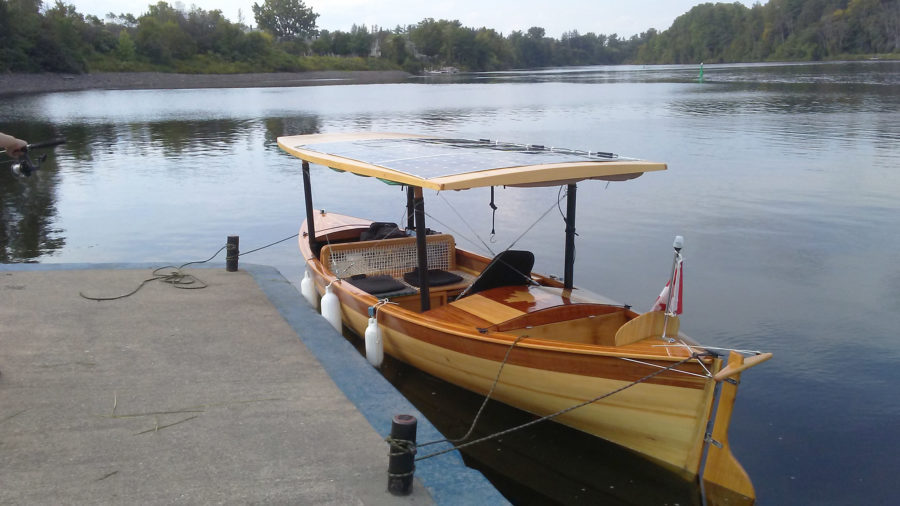
A Solar Solo
SOL CANADA had been performing fairly well, but about once an hour the motor would just stop. I could get it going again by putting the throttle neutral for a…
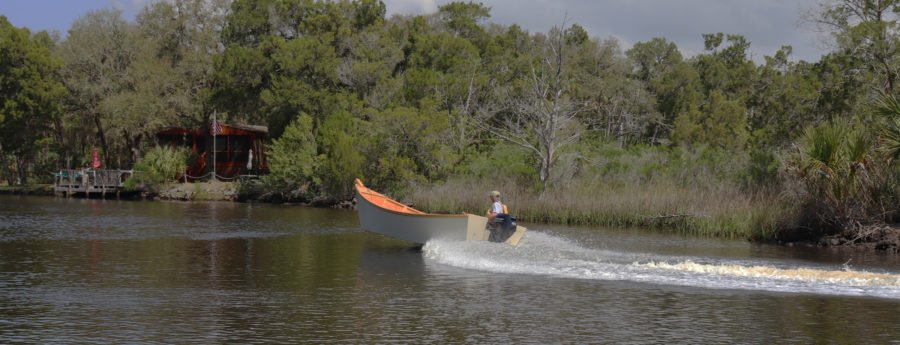
Carolinian Carolina Dory
I came across Spira International’s website on a random internet search. I was intrigued by some of the designs and happily surprised that the boats could be built using construction-grade…
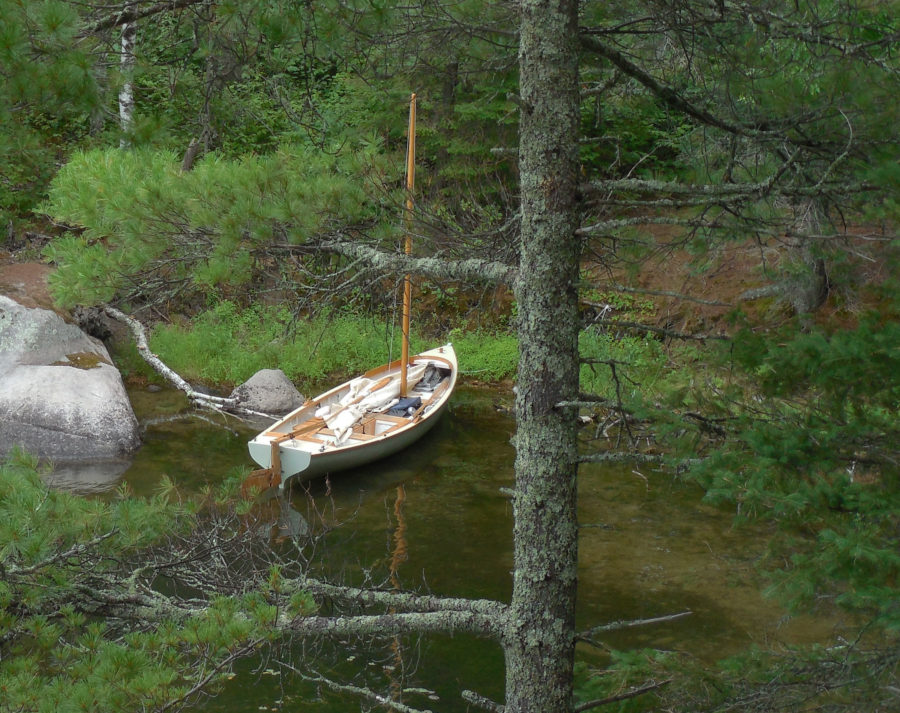
A Red-Lantern Journey
My plan was to head northeast across Sabaskong Bay and into Turtle Lake, a connecting bay with an entrance channel so narrow that its opposing shores merged into a single…
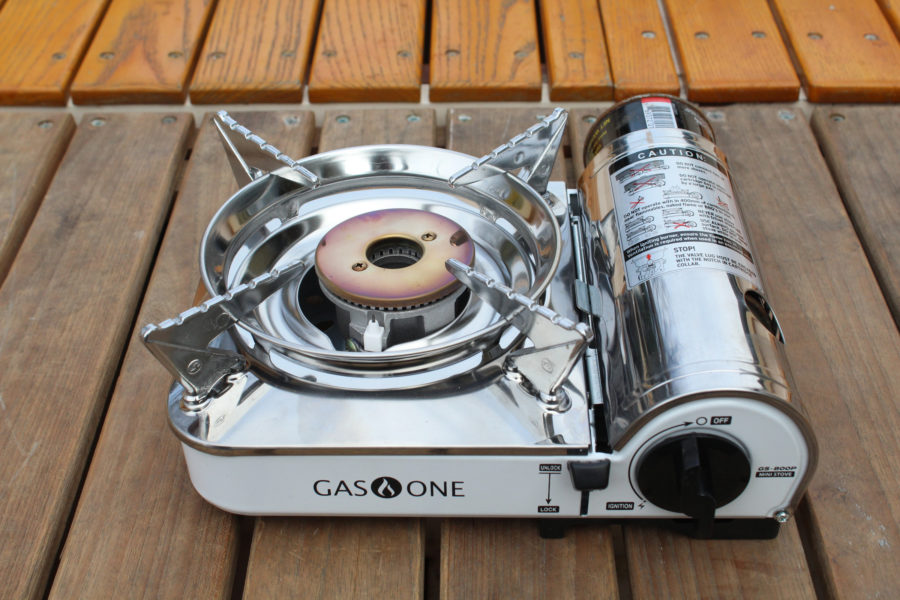
Product Reviews
GasOne’s Mini
I did trials to see how the Mini compared to my familiar stoves. With the air temperature at 46 degrees Fahrenheit and the water from the tap at 52 degrees,…
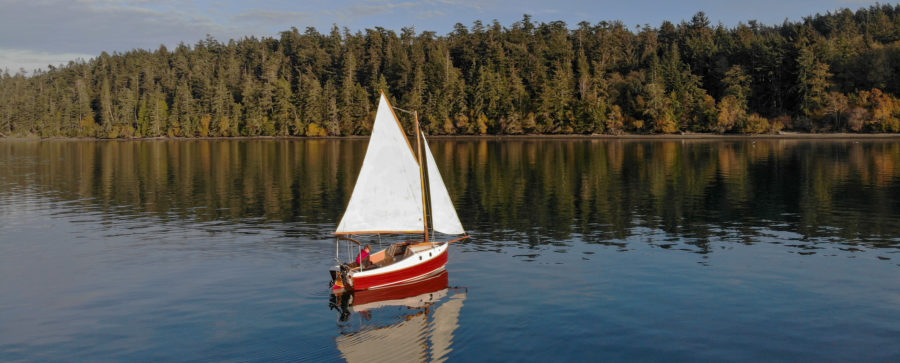
John Harris, the proprietor of and chief designer for Chesapeake Light Craft, designed the PocketShip as his personal boat. “I'd owned a production fiberglass pocket cruiser, which sailed well but…

Under sail, the Weekender is like a sports car and very snappy in response on most points of sail. It can sail remarkably close to the wind for a gaff…

A DIY Cagoule
I lost track of my original cagoule, so I recently re-created a pattern and sewed up two new cagoules. The first was a bit tight over my knees when I…
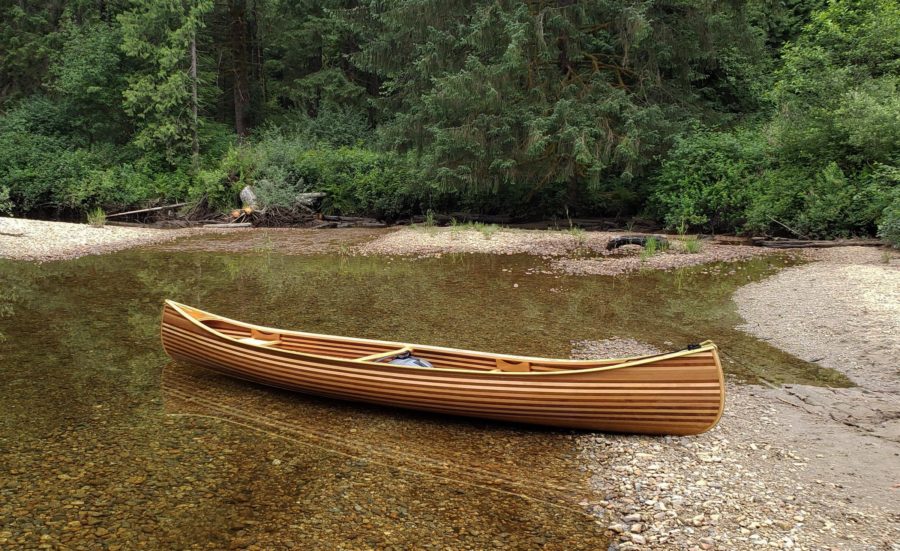
Reader Built Boats
The Yeung Canoe
That fall, Rebecca and Kimberly, now 14 and 12, began work on a Prospector Ranger 15 canoe kit from Bear Mountain Boats. Their father, Winston, helped with the project and…

A Gaff Sloop
Paul Gartside’s 16′ Gaff Sloop, his Design No. 218, has its roots in SJOGIN, a 22′ traditional double-ended Scandinavian workboat built in the late ’50s. Paul designed a modified version…
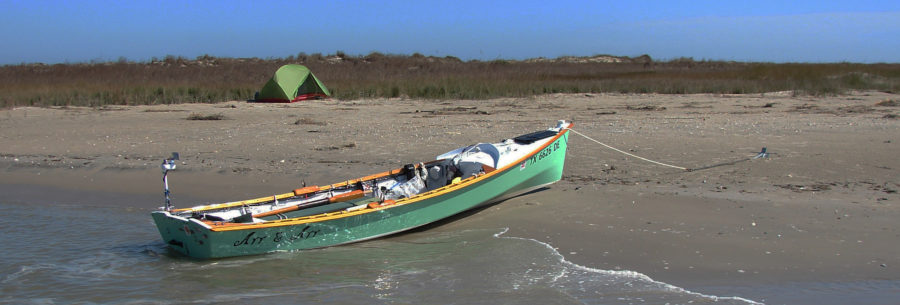
Sunday Pass
For a weekend, the waterways were surprisingly quiet, without a single fisherman in sight, and Port O’Connor resembled a ghost town, inhabited by only birds. Gulls hovered in the breeze;…
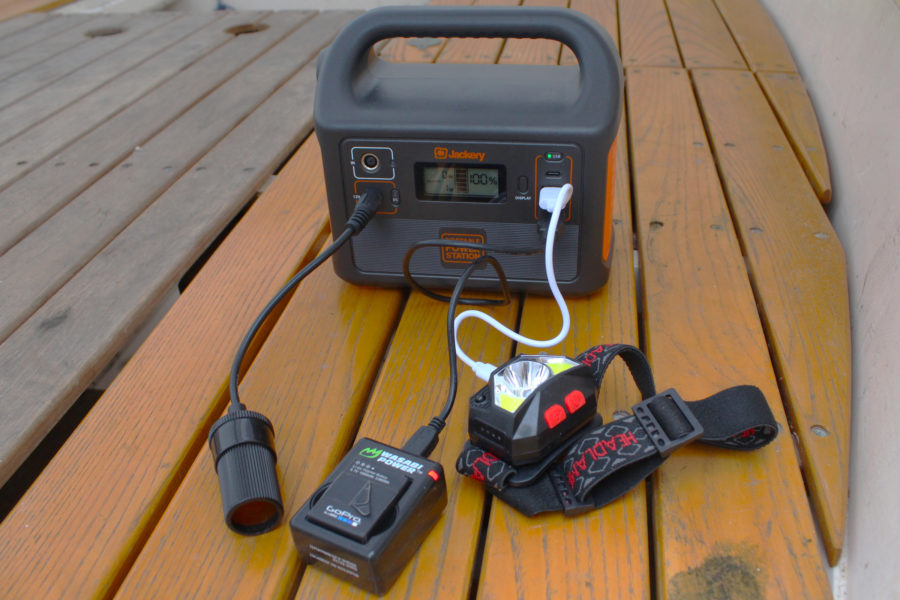
Jackery Explorer 160
The Explorer 160 delivers that capacity in a 7.5″ x 4.75″ x 6.9″ package that weighs just under 4 lbs. The face of the unit has two ports for 12-volt power,…

FALCONE de PALÙ
Detlef Arthur grew up in southern Austria and while he did a lot of boating on lakes and rivers, Italy’s coast was not far away and he occasionally traveled with…
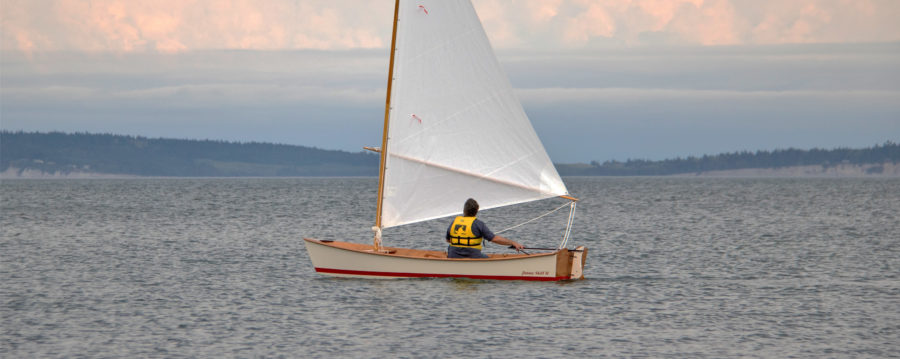
Jimmy Skiff II
Eight plywood panels make up the kit’s hull; its bottom and sides are all composed of two pieces joined together with puzzle joints and the transom is built up of…
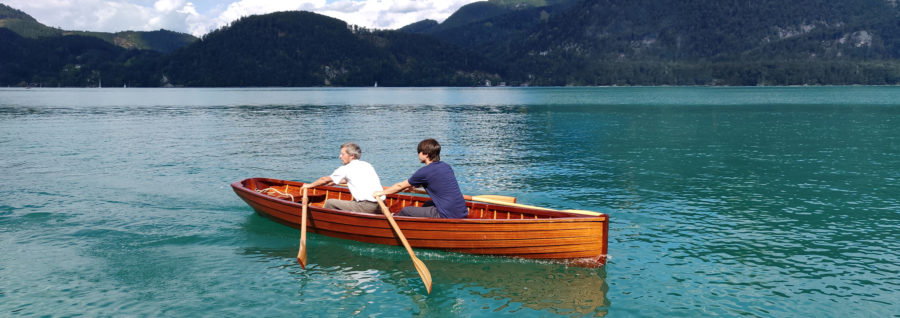
Wolfgangsee skiff
Lukas Schwimann’s home is in the village of St. Gilgen, Austria, at the top end of Lake Wolfgang—Wolfgangsee in German. A friend who lives near him owns a 16′5″ rowing…
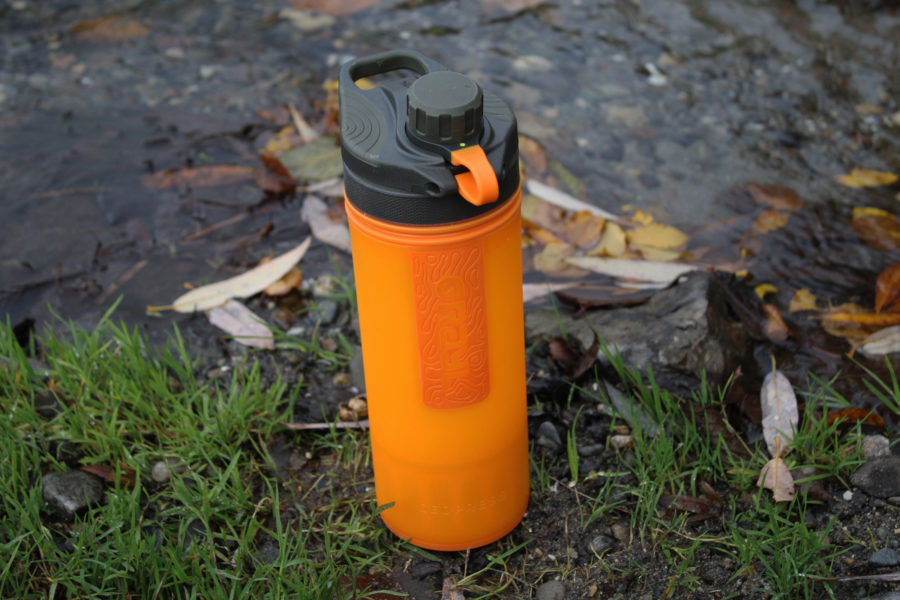
Grayl’s Geopress Water-Treatment System
The filter uses a combination of ceramic fibers for particulate removal, positively charged ions to bind pathogens, and activated carbon to adsorb chemicals and impurities. The manufacturer claims that the…
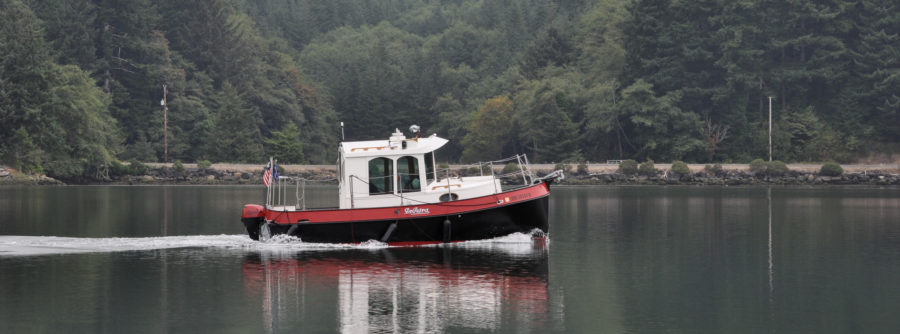
Glen-L Bo-Jest
The three pages of plans were clear, but required extra study for me as this was my first plans-built boat. (I had previously built an Adirondack guideboat from a partial…
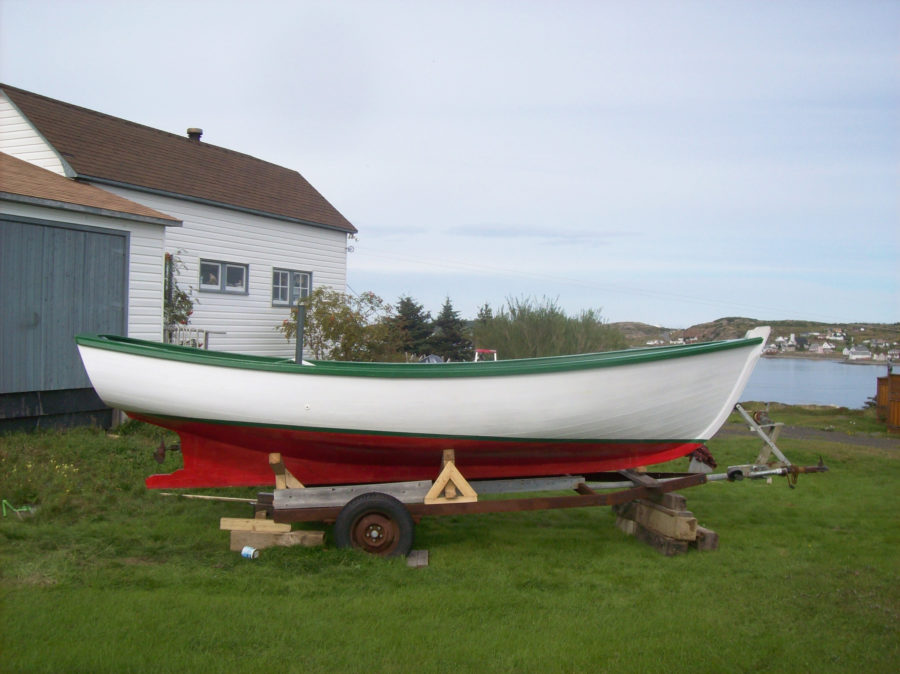
Alf’s Trap Skiff
As a boy, he would surreptitiously take the axe from his father’s shop and chop a boat out of a scrap of wood. There were a number of boatbuilders near…
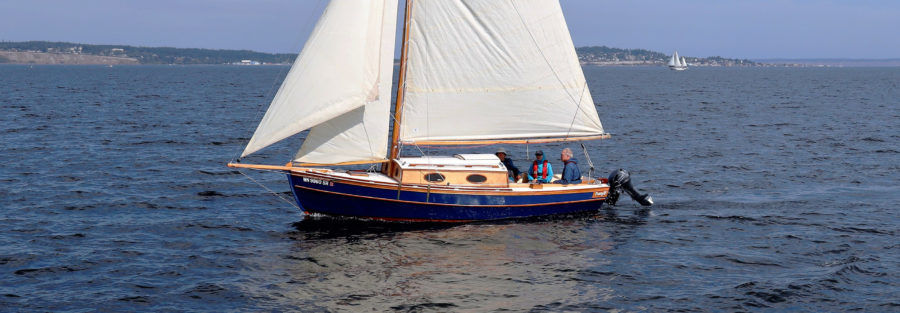
A cruising sailboat in the 20′ to 22′ range resides at the high end of the spectrum that most amateur boatbuilders can realistically aspire to. Go bigger and you need…
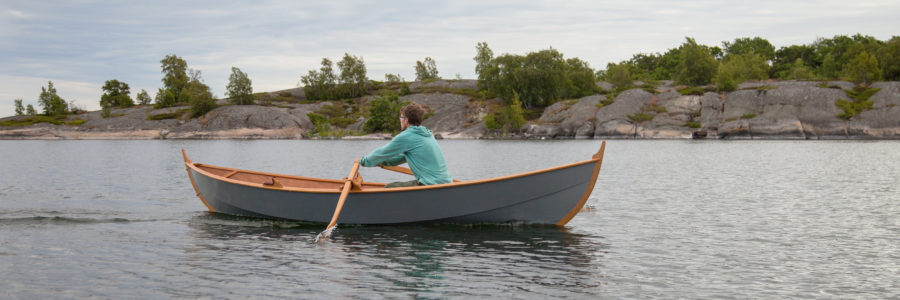
The original faerings were built by hand and eye, and had slowly evolved during hundreds of years to meet the local conditions and particular purposes. Iain carefully studied every design…

Super Sailfish
In 1946, Alex Bryan and Cortlandt Heyniger had combined bits of their first names to create Alcort, Inc., and the first sailboat that they designed, in 1947, was the 11’7”…
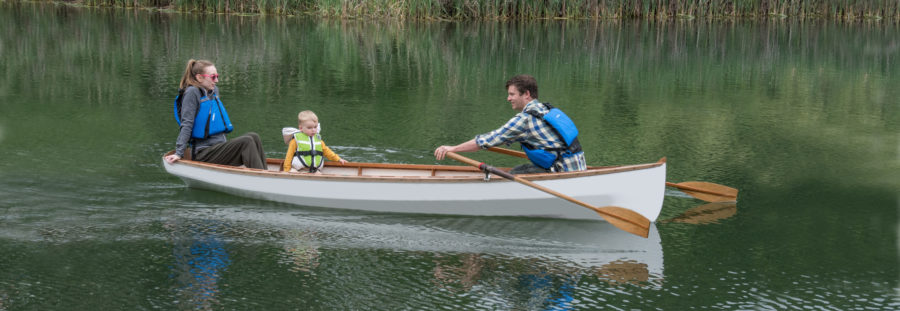
Whitehall Tender
Shenandoah Whitehall
The construction went quickly. Every major project I’ve ever begun has a hidden “gumption trap”—a difficult and unrewarding challenge that sucks the will to persist right out of me. This…
More Boat Profile
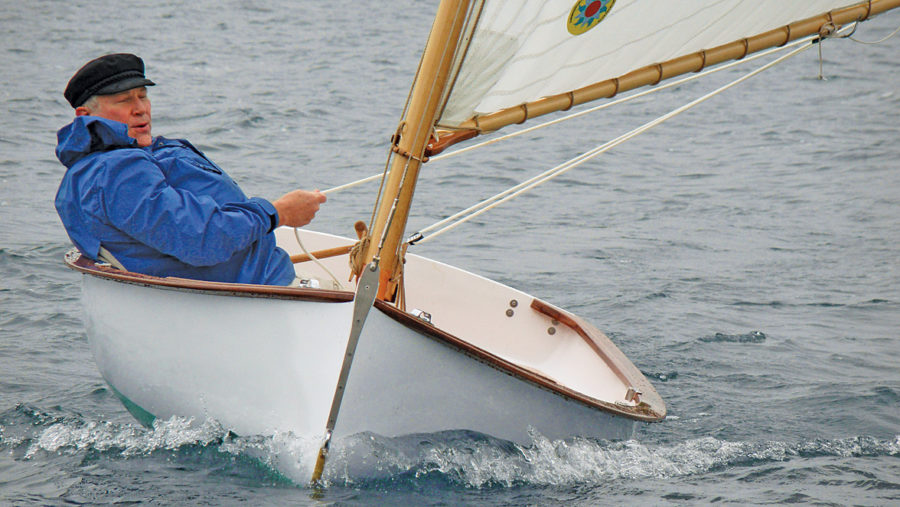
Wittholz 11′ Dinghy
Charles Wittholz designed his traditional 11' catboat dinghy for protected waters. While fun to sail, she is also well suited to work under oars and to serve as a tender…
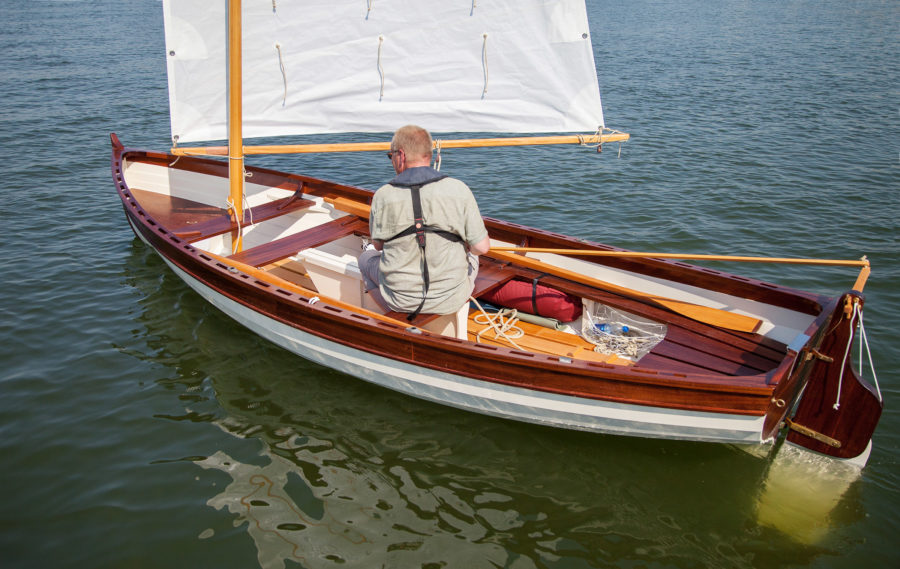
I have been impressed by the solid feel and stability of Penny Fee. Lightly loaded, the transom is well clear of the water, promising good load-carrying capabilities without added drag.…
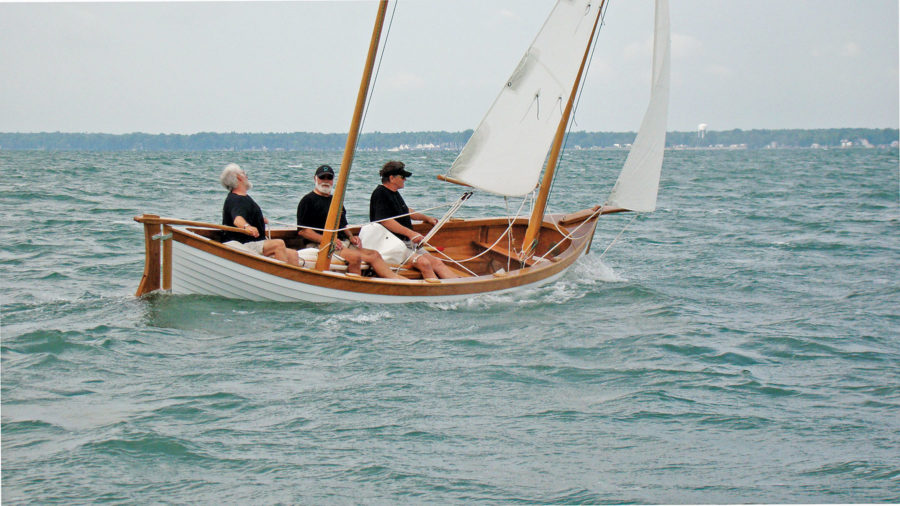
Heritage 23
Conceived as an adaptation of successful programs for rowing and sailing elsewhere, the Heritage 23 was designed by Richard Pierce, to be worked up for kit construction by Jordan Boats.
Subscribe Today!
Become a subscriber today and you’ll recieve a new issue every month plus unlimited access to our full archive of backlogged issues.
Already a subscriber? Sign In

Subscribe For Full Access
Flipbooks are available to paid subscribers only. Subscribe now or log in for access.
Lots of Free Plans!
| These are pretty amazing little models, done entirely by one of our builders, Mr. Kevin Green. There are four boats in paper: The Weekender, The Vacationer, The Pocket Cruiser, and The Wing-Dinghy. | |||||||
All four of the boats above are available to download, plus a bunch of other interesting stuff you might want to consider: He's made a cool program for all three Pocket Yachts which allows a person to test color combinations and print out the paper paterns to make models in colors of one's choosing. What a great way to test out color ideas, compare sizes and interior spaces, and get some great models at the same time! The program has a $5 fee to cover the many hours of time he spent working on these models: The Weekender, The Vacationer, and The Pocket Cruiser. There are also paper models of a racing sloop and plans for a very good looking ship's wheel which could be used on the Weekender or Vacationer, or as a decorative project. Lots of fun projects, and our thanks to Mr. Green for his great work.
The new boat is really great (we think), but along the way a few of the original ideas were left behind. We decided that some of the old concepts still had merit in the right situation, and that some builders might want to choose for themselves how to dress up their boats.
So...Here are a few modifications we have brought back from the original plans. You'll need Adobe's Acrobat Reader 4.0 to view and print these planlets.
The Steering Hatch Plans!
This addendum to the Weekender Plans covers the new Steering Hatch at the stern of the cockpit. This will give MUCH easier access to the steering gear and tiller for adjustments and assembly.
Click Here to download.
The Oval Porthole Plans!
The original Weekender portholes were more elliptical than the current model's oval shape. This little planlet will give you the original pattern to work with.
This PDF file is about 300K. Click Here to download.
The Deadeye Plans!
The first-generation Weekenders had the option of using deadeyes in place of turnbuckles. We've retrieved the information from the old plans so that everyone can have deadeyes if they like. This is the fixed Deadeye file; the first try had some problems opening on Windows machines (we work on Macs). This one should work.
This PDF file is about 1.6MB; be warned. Click Here to download.
The Cockpit Drain Plans!
This is a new addition to the Weekender. We just added this to our boat in early October of 2000. The Weekender cockpit has long needed a way to get the water out when stored or trailering.
It's not self-bailing, but that's not really a possible option in this 16-footer! If you somehow got the cockpit full of water (which hasn't happened to us once in the nearly twenty years of sailing since we first designed the Weekender!), you could open this drain and drop the level down to the waterline. The waterline at the cockpit is usually about an inch to an inch-and-a-half above the cockpit floor. Then you close the drain and use a sponge.
As we stated above: This is more for keeping rain out of the boat. This does happen and it's for this reason we added the drain to our boat.
This PDF file is about 275K. Click Here to download.
The Mast Tabernacle Plans for Pocket Cruiser builders!
In the second version of the Weekender plans we added a mast tabernacle to allow the mast to fold down quickly for easy trailering and launching. If you have the early Weekender plans, or more likely, the Pocket Cruiser plans, you may well want to add this feature to your boat.

| Plywood | 1/2" thick, | 12 sheets |
| Plywood | 3/8" thick, | 1 sheets |
| Plywood | 1/4" thick, | 8 sheets |
ShortyPen.com
- Board Boats
- Day Sailors
- Pocket Cruisers
- Multihull Sailboats
- Contributors
- Shorty Articles
- Contact Shorty
Stevenson Vacationer Sailboat 2003

- Remember me Not recommended on shared computers
Forgot your password?
Or sign in with one of these services
Stevenson Vacationer Plans Updated?
By epoxy15 February 9, 2012 in Main Forum
- Reply to this topic
- Start new topic
Recommended Posts
I'm brand new to this forum. For many reasons, I've decided to revisit Vacationer plans I bought in 2006. Somewhere on the net I read that the plans are not entirely accurate. I've emailed Stevenson with no response. If they have been corrected, I can spring for a new set of plans. Any Response? I understand the limitations of unballasted sailboats so we don't need to go there. I have built boats before, repaired too many and am looking for a simple build to get me on the water. Looking forward to your responses.
Link to comment
Share on other sites.

Of the designs available for a moderate size cruising sloop (this is the most popular size of all the offerings), the Vacationer wouldn't be one of the easiest builds out there, mostly because of the building technique. As to plans updates, I'm not sure, though the common issues have been addressed on a sister forum (BYYB.org) and several options exist for most of the concerns you might have.

Frank Hagan
Mike Stevenson might chime in; he pops in from time to time. The BYYB.ORG site is a good one as more of the Stevenson Projects folks gather over there.
I don't think the plans have been updated since 2006, but I remember that either the Weekender or Vacationer plans had the folding mast and cockpit drain plug incorporated into the plans not too long ago. Something like that.
I built a Weekender, the little sister to the Vacationer, and I think its the perfect size for a little day sailer with style. Very fast to set up and launch; I was often in the water in 15 minutes (rig, launch, tie up and park the truck). The Vacationer may take a bit longer. I'm not sure the extra size of the Vacationer is worth the material cost and extra time to build, as it still doesn't provide headroom in the cabin, etc.

Not sure about Stevenson status or plan updates but here is a link to some of my Vacationer build pics. I had great fun with her but she is not easily rigged for day sailing (heavy mast and lines aplenty to sort out with the gaff) and it was a bit cumbersome to rig and launch solo because of her size. Very fast sailer and would ghost along on no breeze at all.
Hope this helps with you decision.
https://picasaweb.google.com/106668203767680037177/VacationerWeb?authkey=Gv1sRgCOK4_K_u4azLzQE
Great info, Jim. I launched my Weekender solo frequently. After floating her off the trailer, I would grab the bowsprit and swing her around so I could sail away from the dock. I can't do that with my Potter 19 (about the size of the Vacationer in length).
The bow sprit does make a great handle and docking device. It is also great incentive for power boaters to leave you a little elbow room at the ramp (woop woop raming speed capt.)
Brian Walters
Acctually there was an issue with lofting the deck's, i cant look for it now as I am at work but i do have a revised pic of the deck lofting on my website brisboatyard.com I will see if i can get it on here for ya later today.
ok let me see if i can post this here.
there that is the deck fix . I changed quite a few things on my build though.
Join the conversation
You can post now and register later. If you have an account, sign in now to post with your account.

× Pasted as rich text. Paste as plain text instead
Only 75 emoji are allowed.
× Your link has been automatically embedded. Display as a link instead
× Your previous content has been restored. Clear editor
× You cannot paste images directly. Upload or insert images from URL.
- Submit Reply
Supporting Members
- Existing user? Sign In
- Become a Supporting Member
- Leaderboard
- Online Users
- Email Delivery Problems
- All Activity
- Create New...
Important Information
By using this site, you agree to our Terms of Use .
BYYB Forums
- BYYB Forums > Forums > Builders Bulletin Board >
Stevenson Vactioner

Post Jan 05, 2019 #1 2019-01-05T18:10+00:00
RE: Stevenson Vactioner
Post Jan 06, 2019 #2 2019-01-06T12:36+00:00
Post Jan 07, 2019 #3 2019-01-07T20:46+00:00
Post Jan 07, 2019 #4 2019-01-07T22:31+00:00
Post Jan 08, 2019 #5 2019-01-08T01:02+00:00
Post Jan 08, 2019 #6 2019-01-08T01:41+00:00
Post Jan 08, 2019 #7 2019-01-08T02:33+00:00
Post Jan 08, 2019 #8 2019-01-08T02:40+00:00
Post Jan 10, 2019 #9 2019-01-10T12:42+00:00
Choose Display Mode
- Bahasa Indonesia
- Slovenščina
- Science & Tech
- Russian Kitchen
Cruising the Moskva River: A short guide to boat trips in Russia’s capital

There’s hardly a better way to absorb Moscow’s atmosphere than on a ship sailing up and down the Moskva River. While complicated ticketing, loud music and chilling winds might dampen the anticipated fun, this checklist will help you to enjoy the scenic views and not fall into common tourist traps.
How to find the right boat?
There are plenty of boats and selecting the right one might be challenging. The size of the boat should be your main criteria.
Plenty of small boats cruise the Moskva River, and the most vivid one is this yellow Lay’s-branded boat. Everyone who has ever visited Moscow probably has seen it.

This option might leave a passenger disembarking partially deaf as the merciless Russian pop music blasts onboard. A free spirit, however, will find partying on such a vessel to be an unforgettable and authentic experience that’s almost a metaphor for life in modern Russia: too loud, and sometimes too welcoming. Tickets start at $13 (800 rubles) per person.
Bigger boats offer smoother sailing and tend to attract foreign visitors because of their distinct Soviet aura. Indeed, many of the older vessels must have seen better days. They are still afloat, however, and getting aboard is a unique ‘cultural’ experience. Sometimes the crew might offer lunch or dinner to passengers, but this option must be purchased with the ticket. Here is one such option offering dinner for $24 (1,490 rubles).

If you want to travel in style, consider Flotilla Radisson. These large, modern vessels are quite posh, with a cozy restaurant and an attentive crew at your service. Even though the selection of wines and food is modest, these vessels are still much better than other boats.

Surprisingly, the luxurious boats are priced rather modestly, and a single ticket goes for $17-$32 (1,100-2,000 rubles); also expect a reasonable restaurant bill on top.
How to buy tickets?
Women holding photos of ships promise huge discounts to “the young and beautiful,” and give personal invitations for river tours. They sound and look nice, but there’s a small catch: their ticket prices are usually more than those purchased online.
“We bought tickets from street hawkers for 900 rubles each, only to later discover that the other passengers bought their tickets twice as cheap!” wrote (in Russian) a disappointed Rostislav on a travel company website.
Nevertheless, buying from street hawkers has one considerable advantage: they personally escort you to the vessel so that you don’t waste time looking for the boat on your own.

Prices start at $13 (800 rubles) for one ride, and for an additional $6.5 (400 rubles) you can purchase an unlimited number of tours on the same boat on any given day.
Flotilla Radisson has official ticket offices at Gorky Park and Hotel Ukraine, but they’re often sold out.
Buying online is an option that might save some cash. Websites such as this offer considerable discounts for tickets sold online. On a busy Friday night an online purchase might be the only chance to get a ticket on a Flotilla Radisson boat.
This website (in Russian) offers multiple options for short river cruises in and around the city center, including offbeat options such as ‘disco cruises’ and ‘children cruises.’ This other website sells tickets online, but doesn’t have an English version. The interface is intuitive, however.
Buying tickets online has its bad points, however. The most common is confusing which pier you should go to and missing your river tour.

“I once bought tickets online to save with the discount that the website offered,” said Igor Shvarkin from Moscow. “The pier was initially marked as ‘Park Kultury,’ but when I arrived it wasn’t easy to find my boat because there were too many there. My guests had to walk a considerable distance before I finally found the vessel that accepted my tickets purchased online,” said the man.
There are two main boarding piers in the city center: Hotel Ukraine and Park Kultury . Always take note of your particular berth when buying tickets online.
Where to sit onboard?
Even on a warm day, the headwind might be chilly for passengers on deck. Make sure you have warm clothes, or that the crew has blankets ready upon request.
The glass-encased hold makes the tour much more comfortable, but not at the expense of having an enjoyable experience.

Getting off the boat requires preparation as well. Ideally, you should be able to disembark on any pier along the way. In reality, passengers never know where the boat’s captain will make the next stop. Street hawkers often tell passengers in advance where they’ll be able to disembark. If you buy tickets online then you’ll have to research it yourself.
There’s a chance that the captain won’t make any stops at all and will take you back to where the tour began, which is the case with Flotilla Radisson. The safest option is to automatically expect that you’ll return to the pier where you started.
If using any of Russia Beyond's content, partly or in full, always provide an active hyperlink to the original material.
to our newsletter!
Get the week's best stories straight to your inbox
- What to do in Moscow City, if you’re not mega-rich
- Moscow after dusk: 10 places to drink, dance, and groove
- 5 things you must do in Moscow in 2018 between football matches (or without them)
- Sandwiched between Moscow and St. Petersburg: How to spend a perfect weekend in Tver
- 24 or 48 hours in Moscow: Where to go and what to do in 2019
This website uses cookies. Click here to find out more.

Welcome to the Wonderful World of Weekenders!
The Weekender has been our most popular boat design for many years, and we understand why: It has a Classic Style, based loosely on the amazginly pretty Friendship Sloops of New England, and the Weekender is a perfect size for "simply messing about in boats"! It's small enough to be easy to handle, to build, and to store, yet it's still roomy enough to stay overnight in (or just take a nap on a nice afternoon in your driveway, as we've done more than a few times!)
Over Forty Years ago we first brought out this design amnd it has remained one of our most popular boats — And we quite agree with our builders: It's our favorite, too!
Read On to learn more about this Amazing Boat!

NOW AVAILABLE AS DIGITAL PLANS and VIDEO!!
For many years people have been asking us to bring out a digital version of the Weekender plans for download. Well, the Weekender plans have just been completely gone through (updated drawings, new Plans Addenda for improvements, and new additions to the text!) and we are now offering Immediate Digital Download of the plans!
AND...We Now Have the whole of the 3 1/2-hour Weekender Home Boatbuilding Course available as downloadable or streaming video!
Just as the plans needed to move to a more modern format, so too did the Weekender Boatbuilding Video. We shifted forward from VHS tapes to DVDs, and now on to online video files which you can stream or download to a tablet or laptop for use in the workshop!
Order the Weekender Plans, the Video Series, or BOTH below, and scroll down this page to learn LOTS more about the Weekender!

The Weekender in Small Boats Magazine!
Read the article they published about our weekender design.
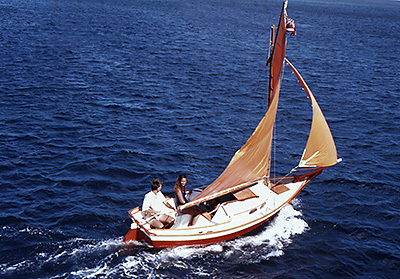
Click Here to go to the Pocket Yacht Model Page.

Printed plans are available on a limited basis: Contact us for more information. (The DIGITAL ones are better!)
If you would prefer the video on DVD, rather than online video, please Click Here.
Click Here for more information.
Click Here to start exploring the photo galleries!

Copyright 2024 Stevenson Projects LLC
Moscow West Mission
Monday, june 18, 2012, mission conference.

No comments:
Post a comment.

IMAGES
COMMENTS
The Vacationer turned out 21' on deck (24' overall), with the same type of shoal draft, full-length keel and clipper bow that worked so well on the Weekender. She has built in camping fixtures and a more rakish cabin than the Weekender. The Vacationer is a pretty good-sized boat, with a nice smooth sailing feel to match.
11-21-2008, 06:32 PM. Re: Concensus on Stevenson's Projects Vacationer and/or Weekender. I guy around here built one, sailed it once, was hugely disappointed, left it on its trailer for a long time (rotting), then tried to sell it for $5K. He ended up donating it to a charity auction where it was bought by a local boat builder for $100 who put ...
Bought a Stevenson Vacationer skeleton from someone who started the project and then bailed. Finished it, made the sails, rigged it, built the trailer, saile...
The Vacationer is a big, elegant sailboat and the wonderful photos Builder/Skippers have shared of their projects really shows this! We are glad to be able share them with you here and think you'll enjoy all the great work these people have done! Click on the pages listed below—Have fun! (and remember: You can click on most of the pics to see ...
Sm Devlin is a well-respected designer. I suspect the Eider will be the better boat by far, but I've never seen one in person--just pictures. The Stevenson boats do not use traditional construction methods, but are more like simple boat-shaped boxes. The Vacationer is about 6.4 m long not counting the bowsprit; the Eider is about 5.3 m long.
Building cherished memories and a wooden sailboat together as a family has been an incredible journey! From sawing the first plank to hoisting the sails, eve...
The Weekender, like the Vacationer and Skipjack, does tack fine, and it is an unballasted boat that is not self-righting. That's the nature of the beast, and I'm sorry if it didn't meet the expectations of a different boat. ... It is what it is: a cute, easy-to-build little sailboat with a classic-boat feel. Mike Stevenson Stevenson ...
11-22-2008, 12:31 PM. Re: Concensus on Stevenson's Projects Vacationer and/or Weekender. The Weekender was probably the first cabin design I ever considered building, mostly for inland cruising. As my garage happened to be built around a Mini Cooper back in the '60s I quickly turned my attention to the Pocket Cruiser instead.
The program has a $5 fee to cover the many hours of time he spent working on these models: The Weekender, The Vacationer, and The Pocket Cruiser. There are also paper models of a racing sloop and plans for a very good looking ship's wheel which could be used on the Weekender or Vacationer, or as a decorative project. ... The new boat is really ...
Vacationer Pocket Yacht. Stevenson's Project, Length: 21', Beam: 8' ... Small Boats Database. Places. Great sailing grounds around Ottawa. Contact us
The Pocket Yachts are at the core of Stevenson Projects' building adventures. These four boats are our most popular projects and can offer great adventures — sporty sailing fun, romantic weekend cruises, transformative summer projects, swashbuckling journeys exploring your local lake — thousands of builders have had all sorts of satisfying experiences in these boats.
Stevenson Vacationer Sailboat 2003 Article By Shorty Definately a star of the day, was Bob Taylor's Vacationer. This boat is so beautiful, is is featured on the Stevenson Projects website with it's own page. Bob built a couple of Piraguas and got interested in sailing. I was giving up my brick at the time and Bob picked it up.
Mike Stevenson might chime in; he pops in from time to time. The BYYB.ORG site is a good one as more of the Stevenson Projects folks gather over there. I don't think the plans have been updated since 2006, but I remember that either the Weekender or Vacationer plans had the folding mast and cockpit drain plug incorporated into the plans not too ...
I bought the Glen-L 21CB, with trailer, for $100.00 (no lie!). I recently purchased a Catalina 22 in good condition, with trailer, for $2600.00. The Catalina 22 is similar in size to the Vacationer, has larger (self-draining) cockpit, pop-top cabin roof for standing cabin headroom, dinette, settee, galley, potti, and can sleep 4.
Learn more about this boat in our March 2020 Issue of Small Boats Magazine: https://smallboatsmonthly.com/article/weekender/Subscribe: https://smallboatsmont...
Re: Concensus on Stevenson's Projects Vacationer and/or Weekender. Just found this online. It's not me selling it. For sale about 1 hour north of S.F.: Stevenson Triad, $595. Includes trailer, electric motor, sail, rig, oars... As a pretty powerboat for lake fishing I think that's quite a deal.
Jan 5, 2023 - Explore Stevenson Projects's board "Stevenson Projects Sailboats", followed by 6,690 people on Pinterest. See more ideas about stevenson, sailboat plans, boat plans.
The Home Of Stevenson Projects. Builder Photo Pages. Boats & Such! Swimming Pools Plus! Cars, Toys, n'More! Sail Sets. Join Our Mailing List.
Prices start at $13 (800 rubles) for one ride, and for an additional $6.5 (400 rubles) you can purchase an unlimited number of tours on the same boat on any given day.
Get warmed up for the World Cup final and see the sights with this awesome set from the legend that is Paul Oakenfold on the #buboat in Moscow.
The Weekender has been our most popular boat design for many years, and we understand why: It has a Classic Style, based loosely on the amazginly pretty Friendship Sloops of New England, and the Weekender is a perfect size for "simply messing about in boats"! It's small enough to be easy to handle, to build, and to store, yet it's still roomy ...
In attendance were six general authorities which included Elder D. Todd Christofferson, of the Quorum of the twelve, Elder Ronald A. Rasband, Senior President of the Seventy, Bishop Gary F. Stevenson Presiding Bishop, Elders Gregory A. Schwitzer, Larry R. Lawrence, and Ronald K. Bennett of the East Europe area presidency.
INMOTION SCV at MOSCOW BOAT SHOW 2014.For More details,https://www.inmotionworld.comFollow INMOTION Facebook,https://www.facebook.com/InmotionWorldFollow INM...